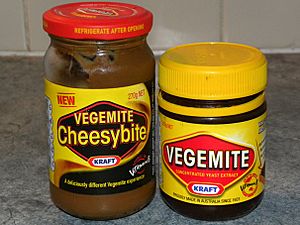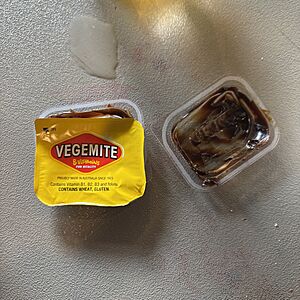Vegemite facts for kids
| Lua error in Module:WikidataIB at line 168: attempt to index field 'wikibase' (a nil value).
Vegemite on toast
|
|
| Type | Lua error in Module:WikidataIB at line 168: attempt to index field 'wikibase' (a nil value). |
|---|---|
| Inventor | Lua error in Module:WikidataIB at line 168: attempt to index field 'wikibase' (a nil value). |
| Inception | Lua error in Module:WikidataIB at line 168: attempt to index field 'wikibase' (a nil value). |
| Manufacturer | Lua error in Module:WikidataIB at line 168: attempt to index field 'wikibase' (a nil value). |
| Website | Lua error in Module:WikidataIB at line 168: attempt to index field 'wikibase' (a nil value). |
Vegemite is a thick, dark brown food spread from Australia. It's made from leftover yeast extract from brewing beer, mixed with different vegetable and spice flavors. Cyril Callister created Vegemite in Melbourne, Australia, in 1922. It was first sold in stores on October 25, 1923.
People usually spread Vegemite on sandwiches, toast, crumpets, and crackers. It can also be a filling for pastries. Vegemite is similar to other spreads made from yeast, like Marmite from the UK and New Zealand, and other Australian spreads such as Promite.
Vegemite has a very strong taste. It is salty, a little bitter, and malty. It also has a savory taste called umami, like beef broth, because it's rich in glutamates. Vegemite is suitable for vegans, kosher, and halal diets. It is also known for having lots of B vitamins.
After Fred Walker, the founder, passed away in 1935, an American company called Kraft Foods owned the Vegemite brand. But in 2017, an Australian company called Bega Group bought Vegemite. This brought the brand back to Australian ownership.
Contents
History
How Vegemite Started
After World War I, it was hard to get Marmite from Britain in Australia. So, in 1919, an Australian company called Fred Walker & Co. asked Cyril Callister to create a new spread. Callister was asked to use the leftover yeast that breweries were throwing away.
Callister used a special process to break down the yeast cells from waste yeast. He got this yeast from the Carlton & United brewery. He then made a clear liquid extract, added salt, and extracts from celery and onion. This created a sticky black paste.
Fred Walker's daughter, Sheilah, chose the name "Vegemite" in a competition that offered a prize of £A50. The name was registered as a trademark in Australia in 1919. Vegemite first appeared in stores in 1923. Early advertisements said it was good for children's health, but it didn't sell well.
From 1928 to 1935, the product was renamed "Parwill." This was part of an advertising slogan: "Marmite but Parwill." This was a play on words, meaning "If Ma [mother] might... then Pa [father] will." This effort to sell more didn't work, and the name went back to Vegemite.
Becoming Popular
In 1925, Fred Walker started a joint company with J. L. Kraft & Bros called Kraft Walker Cheese Co. This company sold processed cheese. After "Parwill" failed, Walker used the success of Kraft Walker Cheese to help sell Vegemite in 1935. After Walker died, Kraft Walker Cheese Co. took over the Fred Walker Company.
To boost sales, Vegemite was given away for free with Kraft Walker cheese products. There were also poetry competitions with new Pontiac cars as prizes. Sales increased, and in 1939, the British Medical Association officially said Vegemite was a great source of B vitamins. During World War II, Vegemite was rationed in Australia and included in Australian Army food packs. By the late 1940s, nine out of ten Australian homes used Vegemite.
Recent Times
In April 1984, a 115-gram jar of Vegemite was the first product in Australia to be scanned electronically at a checkout.
Vegemite is still made in Australia at its Port Melbourne factory. This factory makes over 22 million jars every year. The recipe is almost the same as Cyril Callister's original one. Today, Vegemite sells much more than Marmite and other similar spreads in Australia. The billionth jar of Vegemite was made in October 2008.
Vegemite was also made in New Zealand for over 50 years. However, production stopped there in August 2006. The New Zealand version of Marmite is still very popular there.
Bega Cheese Buys Vegemite
Mondelez International owned the Vegemite brand until January 2017. Then, the Australian Bega Group bought it. This deal, worth US$460 million, meant that Vegemite and other food businesses in Australia and New Zealand became Australian-owned again.
How People Eat Vegemite
A common way to eat Vegemite is on toasted bread with butter or margarine. You only need a small amount of Vegemite because its flavor is very strong. A Vegemite sandwich usually has two slices of buttered bread and Vegemite. Some people also add cheese, lettuce, avocado, or tomato.
Vegemite can be used as a filling for pastries, like the cheesymite scroll. It can also be used in more interesting dishes.
The official Vegemite website has many recipes that use Vegemite. These include pasta, burgers, pizzas, casseroles, and even ice cream. It has also been suggested to add Vegemite to soups or instant noodles.
Kosher and Halal Certification
Small amounts of kosher Vegemite were first made in the 1980s. In 2004, there was a plan to stop making it kosher, but this decision was changed after Jewish customers complained. Around 2009, Kraft worked with the Kashrut Authority in New South Wales for their kosher supervision. By 2010, all regular Vegemite jars and tubes had the authority's kosher stamp. In 2010, Vegemite also received halal certification.
Vegan Certification
The makers of Vegemite have always said it was suitable for vegans. However, it wasn't until World Vegan Day in 2019 that it officially received vegan certification. A Vegemite nutritionist said that "the spread had always been a fitting choice for vegans."
What's in Vegemite?
Vegemite is a good source of B vitamins. These include thiamine (B1), riboflavin (B2), niacin (B3), and folate (B9). The regular version does not have vitamin B12. However, both vitamin B6 and vitamin B12 are added to the low-salt version.
The main ingredient in Vegemite is yeast extract. This extract has a lot of glutamic acid, which gives Vegemite its savory umami flavor. Vegemite does not contain any fat, added sugar, or animal products. It does contain gluten because the yeast comes from brewing.
One 5-gram serving of Vegemite has 173 mg of sodium. This is 8% of the daily recommended amount of sodium. Australia only defines low-salt foods. However, by UK standards, Vegemite is considered a high-salt food.
A low-salt version of Vegemite was released in September 2014. It has 25% less sodium. The low-salt version also has added vitamin B6 and vitamin B12.
Advertising and Branding
At first, Vegemite was advertised as a healthy food for children. During World War II, ads focused on its health benefits:
Vegemite fights with the men up north! If you are one of those who don't need Vegemite medicinally, then thousands of invalids are asking you to deny yourself of it for the time being.
At the same time, "Sister MacDonald" said in magazines that Vegemite was important for "infant welfare." Later ads started to promote how important B complex vitamins are for health.
Vegemite became very popular thanks to advertising campaigns that started in 1954. These campaigns featured groups of smiling, healthy children singing a catchy song called "We're happy little Vegemites."
- We're happy little Vegemites
- As bright as bright can be.
- We all enjoy our Vegemite
- For breakfast, lunch, and tea.
- Our mummies say we're growing stronger
- Every single week,
- Because we love our Vegemite
- We all adore our Vegemite
- It puts a rose in every cheek.
The song was first played on the radio in 1954 and then on television in 1956. This advertising campaign continued until the late 1960s. It was aimed at children, but later ads promoted the product to all ages. In the late 1980s, the original black and white TV commercial was updated and partly colored. It was shown on TV from 1991 to 2010. The two young twin girls who sang this song were known as the "Vegemite Twins."
In March 2007, Kraft announced they were looking for the eight original children from the campaign. They wanted to celebrate the ad's 50th anniversary and create a new campaign. The 1956 commercial was remade with the original children, who were now adults. This helped connect the new generation with the old ad. The media helped find all eight children in eight days. This led to many TV specials and interviews in Australia. The 50-year reunion campaign won an award in November 2007.
Different Kinds of Vegemite
Vegemite Singles
In the 1990s, Kraft released Vegemite Singles in Australia. This product combined Kraft Singles cheese with Vegemite flavor. It was an attempt to use the popularity of Vegemite and cheese sandwiches. Vegemite Singles were later taken off the market.
Vegemite Cheesybite
On June 13, 2009, Kraft released a new version of Vegemite. This new formula mixes Vegemite with Kraft cream cheese. It spreads more easily and has a much milder and less salty taste than the original. Kraft held a competition to name the new flavor. The new name was announced as iSnack 2.0. This name was chosen by experts to appeal to younger people, like Apple's iPod and iPhone.
However, the name was immediately criticized and made fun of in Australia. Within days, people were making fun of it online. After only four days, Kraft decided to change the iSnack name, admitting it was a mistake. Two days later, Kraft held a new poll on its website. The final name, "Vegemite Cheesybite," was announced on October 7, 2009. Kraft said this name received 36% of the votes. The popular suggestion "Cheesymite" was already trademarked by other companies. Under Bega's ownership, the product has been renamed "Vegemite & Cheese."
My First Vegemite
In 2011, Kraft Foods Australia launched "My First Vegemite." This was a special Vegemite for children older than one year. Kraft said the new formula had a "milder taste" and "additional health benefits." These benefits included iron, B6, and B12 vitamins, and 50% less sodium. It was made because customers wanted foods with less sugar and salt. Most people and media reports liked the new formula. However, Kraft Foods Australia stopped selling "My First Vegemite" in 2012 because it didn't sell well.
Chocolate and Vegemite
In April 2015, Cadbury announced they would release a Vegemite-flavored chocolate bar on June 1. This chocolate bar was a Cadbury Caramello block mixed with Vegemite. Some people said it tasted like salted caramel with a nice savory aftertaste. Others had different opinions, from "love it" to "tastes like they mixed the caramel and Turkish delight filling with a lot of salt." Some tasters thought the aftertaste was unpleasant.
Vegemite Blend 17
In 2017, a special version called Vegemite Blend 17 was released for a short time. It promised a "richer, bolder taste" but cost twice as much as the regular product.
Other Products
Other food products that have Vegemite flavor include Smith's Crisps, In a Biskit, bagel crisps, sausages, meat pies, and Arnott's Shapes.
Bans and Rumors of Bans
In October 2006, an Australian news company reported that Vegemite had been banned in the United States. They even said that US Customs officers were searching Australians entering the country for Vegemite. This was because Vegemite naturally contains folate, a B vitamin that is only approved as an additive in a few foods in the US. The US Food and Drug Administration later said there were no plans to ban Vegemite or remove it from stores. US Customs and Border Protection also said there was "no known prohibition on the importation of Vegemite." The story of the "ban" became an urban legend. While Vegemite has never been very popular in the US, you can still buy it in supermarkets that sell imported foods.
In May 2011, newspapers reported that Vegemite and Marmite had been banned in Denmark. Fans were very upset and created Facebook groups. In response, Denmark's Ministry of Food, Agriculture and Fisheries said that neither spread had been banned. Instead, the companies had not applied for licenses to sell their products in Denmark. In 2004, Denmark had passed a law that stopped the sale of foods with added vitamins, saying they could be a health risk.
Vegemite is banned in prisons in Victoria, Australia. These bans started in the 1990s. This was to stop prisoners from trying to make alcohol using the paste's high yeast content. However, Vegemite does not contain live yeast. Similar bans were suggested in 2015 for some remote Australian communities, but they were not put into action.
In 2025, the owner of an Australian-themed cafe in Toronto was told by the Canadian Food Inspection Agency (CFIA) that Vegemite could not be sold in Canada. This was because of its added Vitamin B content. After the Australian government stepped in, the CFIA clarified that the "level of risk to human health from the added vitamins present in the product is low." They then allowed its sale again.
See also
 In Spanish: Vegemite para niños
In Spanish: Vegemite para niños
- List of spreads
- Vegemite wars
- Bonox, Bovril (beef extracts)
- Guinness Yeast Extract (yeast extract)
- Oxo (beef and yeast extract)
- Shelf-stable food





